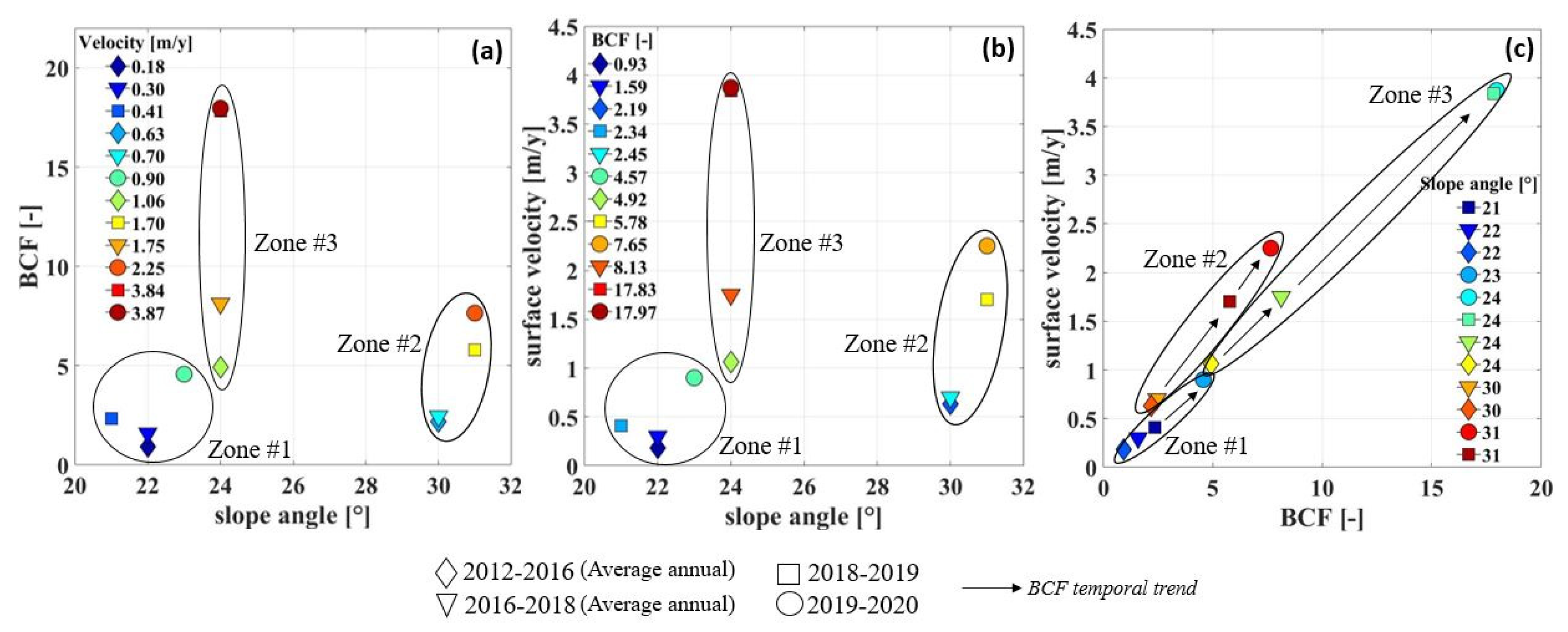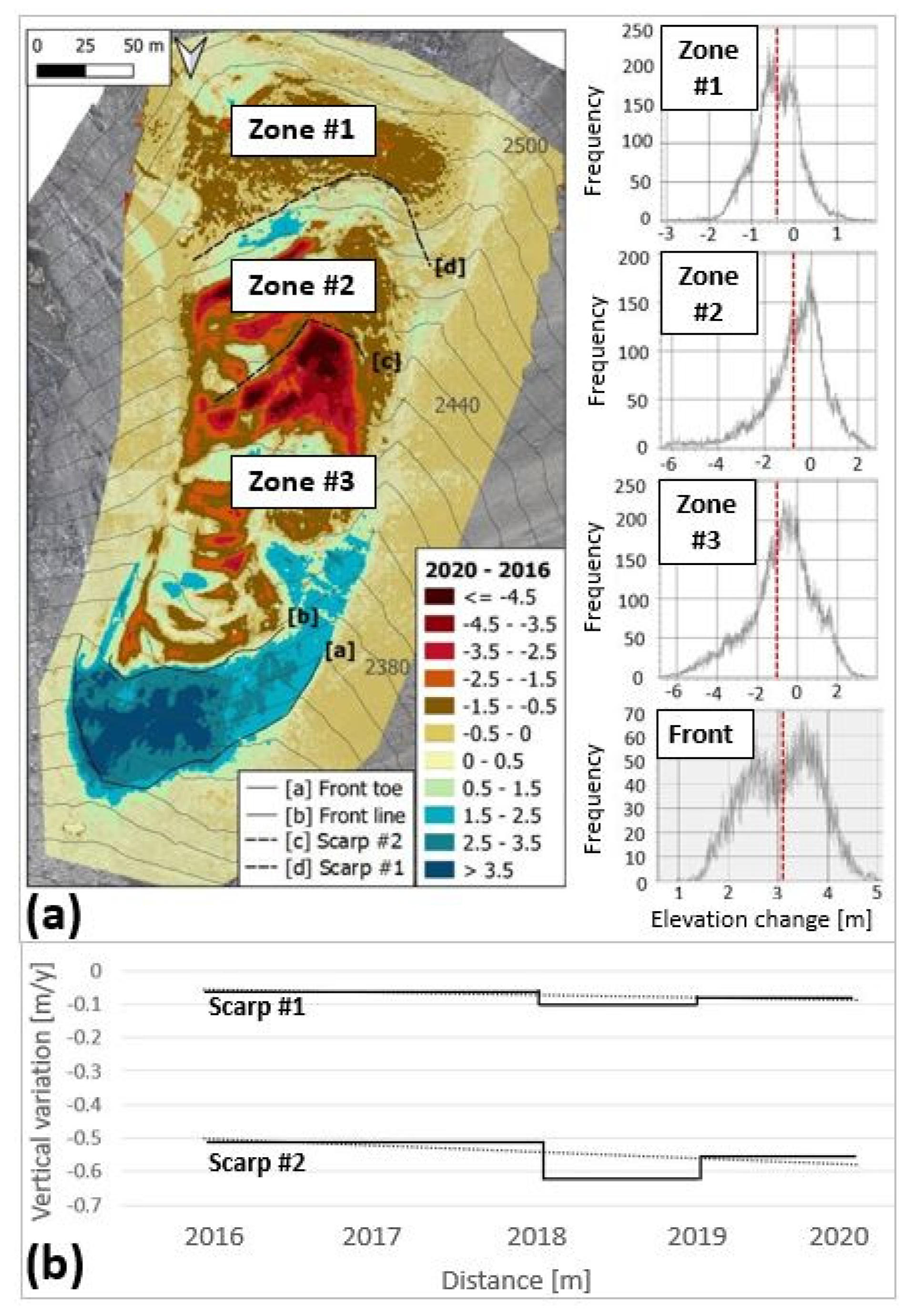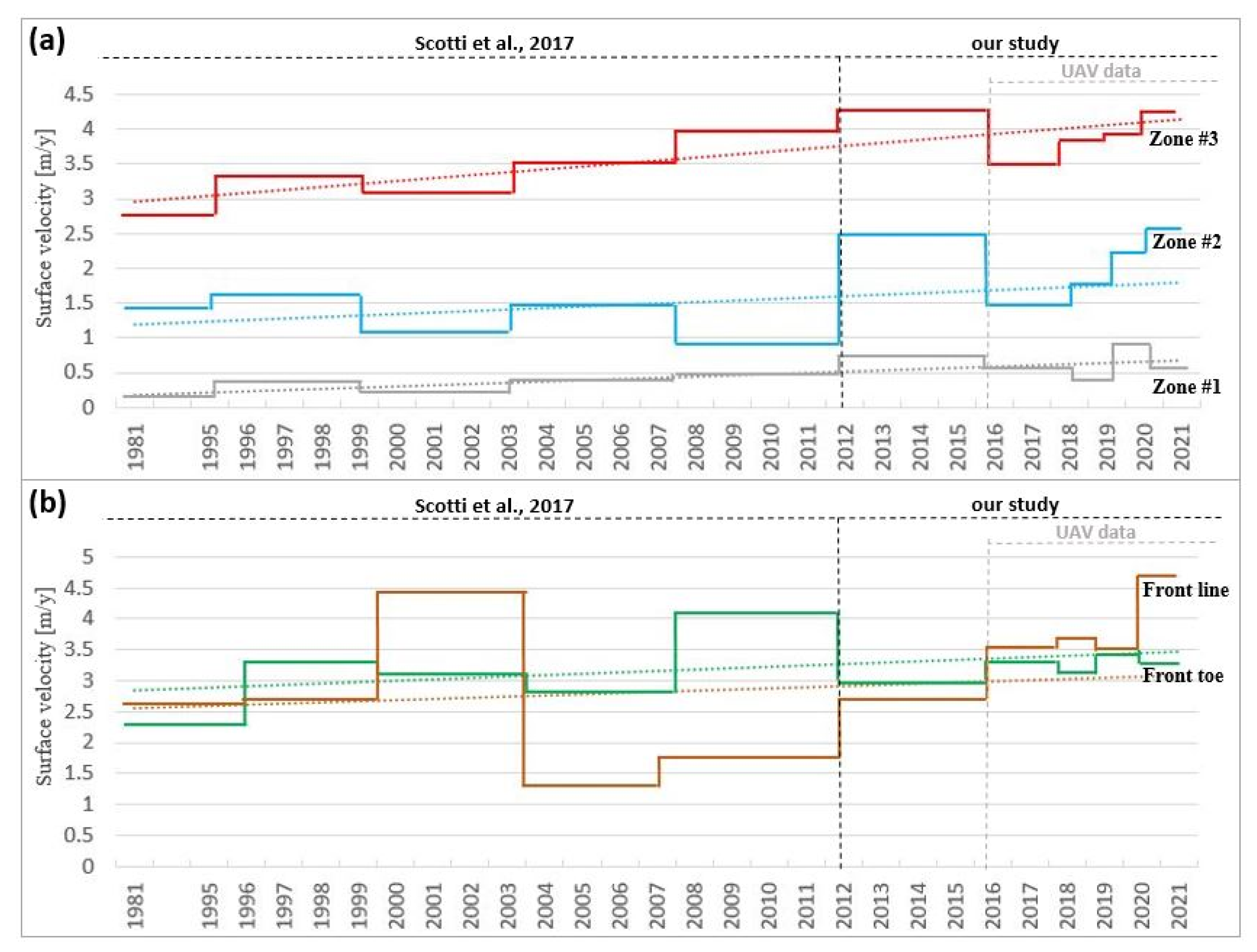Flow Velocity Variations and Surface Change of the Destabilised Plator Rock Glacier (Central Italian Alps) from Aerial Surveys
Abstract
:1. Introduction
2. Study Area
3. Materials and Methods
3.1. Data Acquisition
3.2. Photogrammetric Processing
3.3. Determination of Horizontal Surface Velocities
3.4. The Bulk Creep Factor and Applicability
4. Results
4.1. Accuracy of CIAS Estimates
4.2. Velocity Field Distribution
4.3. Rock Glacier Morphological Changes
4.4. Spatial and Temporal Variability of the Bulk Creep Factor
4.5. Vertical Surface Elevation Changes
5. Discussion
5.1. Evidence of Rock Glacier Destabilisation
5.2. The Bulk Creep Factor Interpretation
5.3. Flow Variations from 1981 to 2020 and Probable Causes of Destabilisation
6. Conclusions
Author Contributions
Funding
Data Availability Statement
Acknowledgments
Conflicts of Interest
References
- Müller, J.; Vieli, A.; Gärtner-Roer, I. Rock glaciers on the run—Understanding rock glacier landform evolution and recent changes from numerical flow modelling. Cryosphere 2016, 10, 2865–2886. [Google Scholar] [CrossRef] [Green Version]
- Haeberli, W.; Hallet, B.; Arenson, L.; Elconin, R.; Humlum, O.; Kääb, A.; Kaufmann, V.; Ladanvi, B.; Matsuoka, N.; Springman, S.; et al. Permafrost creep and rock glacier dynamics. Permafr. Periglac. Processes 2006, 17, 189–214. [Google Scholar] [CrossRef]
- Hartl, L.; Fischer, A.; Stocker-Waldhuber, M.; Abermann, J. Recent speed-up of an alpine rock glacier: An update chronology of the kinematics of outer hochebenkar rock glacier based on geodetic measurements. Geogr. Ann. Ser. A Phys. Geogr. 2016, 98, 129–141. [Google Scholar] [CrossRef]
- Delaloye, R.; Lambiel, C.; Gärtner-Roer, I. Overview of rock glacier kinematics research in the Swiss Alps. Geogr. Helv. 2010, 65, 135–145. [Google Scholar] [CrossRef]
- Cicoira, A.; Beutel, J.; Faillettaz, J.; Gärtner-Roer, I.; Vieli, A. Resolving the influence of temperature forcing through heat conduction on rock glacier dynamics: A numerical modelling approach. Cryosphere 2019, 13, 927–942. [Google Scholar] [CrossRef] [Green Version]
- Seppi, R.; Carturan, L.; Carton, A.; Zanoner, T.; Zumiani, M.; Cazorzi, F.; Bertone, A.; Baroni, C.; Salvatore, M.C. Decoupled kinematics of two neighbouring permafrost creeping landforms in the Eastern Italian Alps. Earth Surf. Process. Landf. 2019, 44, 2703–2719. [Google Scholar] [CrossRef]
- Wirz, V.; Gruber, S.; Purves, R.S.; Beutel, J.; Gärtner-Roer, I.; Gubler, S.; Vieli, A. Short-term velocity variations at three rock glaciers and their relationship with meteorological conditions. Earth Surf. Dynam. 2016, 4, 103–123. [Google Scholar] [CrossRef] [Green Version]
- Staub, B.; Lambiel, C.; Delaloye, R. Rock glacier creep as a thermally-driven phenomenon: A decade of inter-annual observations from the Swiss Alps. In Proceedings of the XI International Conference on Permafrost, Postdam, Germany, 20–24 June 2016; pp. 96–97. [Google Scholar]
- Frauenfelder, R.; Schneider, B.; Kääb, A. Using dynamic modeling to simulate the distribution of rock glaciers. Geomorphology 2008, 93, 130–143. [Google Scholar] [CrossRef]
- Roer, I.; Haeberli, W.; Avian, M.; Kaufmann, V.; Delaloye, R.; Lambiel, C.; Kääb, A. Observations and considerations on destabilizing active rock glaciers in the European Alps. In Proceedings of the 9th International Conference on Permafrost, Fairbanks, Alaska, 29 June–3 July 2008; pp. 1505–1510. [Google Scholar]
- Bodin, X.; Schoeneich, P.; Deline, P.; Rayanel, L.; Magnin, F.; Krysiecki, J.M.; Echelard, T. Mountain permafrost and associated geomorphological processes: Recent changes in the French Alps. J. Alp. Res. 2015, 103. [Google Scholar] [CrossRef] [Green Version]
- Cicoira, A.; Beutel, J.; Faillettaz, J.; Vieli, A. Water controls the seasonal rhythm of rock glacier flow. Earth Planet Sci Lett. 2019, 528, 115844. [Google Scholar] [CrossRef]
- Ikeda, A.; Matsuoka, N.; Kääb, A. Fast deformation of perennially frozen debris in a warm rock glacier in the Swiss Alps an effect liquid water. J. Geophys. Res. Earth Surf. 2008, 113. [Google Scholar] [CrossRef] [Green Version]
- Schoeneich, P.; Bodin, X.; Echelard, T.; Kaufmann, V.; Kellerer-Pirklbauer, A.; Krysiecki, J.M.; Lieb, G.K. Velocity changes of rock glaciers and induced hazards. Eng. Geol. Soc. Territ. 2014, 1, 223–227. [Google Scholar]
- Kenner, R.; Bühler, Y.; Delaloye, R.; Ginzler, C.; Phillips, M. Monitoring of high alpine mass movements combining laser scanning with digital airborne photogrammetry. Geomorphology 2014, 206, 492–504. [Google Scholar] [CrossRef] [Green Version]
- Barsch, D. Permafrost creep and rock glaciers. Permafr. Periglac. Processes 1992, 3, 175–188. [Google Scholar] [CrossRef]
- Bearzot, F.; Garzonio, R.; Di Mauro, B.; Colombo, R.; Cremonese, E.; Crosta, G.B.; Delaloye, R.; Hauck, C.; Morra Di Cella, U.; Pogliotti, P.; et al. Kinematics of an Alpine rock glacier from multi-temporal UAV surveys and GNSS data. Geomorphology 2022. [Google Scholar] [CrossRef]
- Buchli, T.; Kos, A.; Limpach, P.; Merz, K.; Zhou, X.; Springman, S.M. Kinematic investigations on the Furggwanghorn rock glacier, Switzerland. Permafr. Periglac. Processes 2018, 29, 3–20. [Google Scholar] [CrossRef]
- Arenson, L.; Hoelzle, M.; Springman, S. Borehole deformation measurements and internal structure of some rock glaciers in Switzerland. Permafr. Periglac. Processes 2002, 13, 117–135. [Google Scholar] [CrossRef]
- Frehner, M.; Ling, A.H.M.; Gärtner-Roer, I. Furrow-and-ridge morphology on rock glaciers explained by gravity-driven buckle folding: A case study from the Murtèl rock glacier (Switzerland). Permafr. Periglac. Processes 2015, 26, 57–66. [Google Scholar] [CrossRef]
- Cicoira, A.; Marcer, M.; Gärtner-Roer, I.; Bodin, X.; Arenson, L.U.; Vieli, A. A general theory of rock glacier creep based on in-situ and remote sensing observations. Permafr. Priglacial Processes 2021, 32, 139–153. [Google Scholar] [CrossRef]
- Scotti, R.; Crosta, G.B.; Villa, A. Destabilisation of creeping permafrost: The Plator rock glacier case study (central Italian Alps). Permafr. Periglac. Processes 2017, 28, 224–236. [Google Scholar] [CrossRef] [Green Version]
- Scotti, R.; Brardinoni, F.; Alberti, S.; Frattini, P.; Crosta, G.B. A regional inventory of rock glaciers and protalus ramparts in the central Italian Alps. Geomorphology 2013, 186, 136–149. [Google Scholar] [CrossRef]
- Hendrickx, H.; Vivero, S.; De Cock, L.; De Wit, B.; De Maeyer, P.; Lambiel, C.; Delaloye, R.; Nyssesn, J.; Frankl, A. The reproducibility of SfM algorithm to produce detailed Digital Surface Models: The example of PhotoScan applied to a high-alpine rock glacier. Remote Sens. Lett. 2019, 10, 11–20. [Google Scholar] [CrossRef] [Green Version]
- Goetz, J.; Brenning, A.; Marcer, M.; Bodin, X. Modeling the precision of structure-from-motion multi-view stereo digital elevation models from repeated close-range aerial surveys. Remote Sens. Environ. 2018, 210, 208–216. [Google Scholar] [CrossRef]
- Westoby, M.J.; Brasington, J.; Glasser, N.F.; Hambrey, M.J.; Reynolds, J.M. “Structure-from-Motion” photogrammetry: A low-cost, effective tool for geosciences applications. Geomorphology 2012, 179, 300–314. [Google Scholar] [CrossRef] [Green Version]
- Heid, T.; Kääb, A. Evaluation of existing image matching methods for deriving glacier surface displacements globally from optical satellite imagery. Remote Sens. Environ. 2012, 118, 339–355. [Google Scholar] [CrossRef]
- Kääb, A.; Vollmer, M. Surface geometry, thickness changes and flow on creeping mountain permafrost: Automatic extraction by Digital Image Analysis. Permafr. Periglac. Processes 2000, 11, 315–326. [Google Scholar] [CrossRef] [Green Version]
- Vivero, S.; Bodin, X.; Farías-Barahona, D.; MacDonell, S.; Schaffer, N.; Robson, B.A.; Lambiel, C. Combination of aerial, satellite, and UAV photogrammetry for quantifying rock glacier kinematics in the dry Andes of Chile (30 °C) since 1950s. Remote Sens. 2021, 2, 784015. [Google Scholar] [CrossRef]
- Klug, C.; Bollmann, E.; Sailer, R.; Stötter, J. Monitoring of permafrost creep on two rock glaciers in the Austrian Eastern Alps: Combination of aerophotogrammetry and airborne laser scanning. In Proceedings of the 10th International Conference of Permafrost, Salekhard, Russia, 25–29 June 2012; Volume 1, pp. 215–220. [Google Scholar] [CrossRef]
- Debella-Gilo, M.; Kääb, A. Sub-pixel precision image matching for measuring surface displacements on mass movements using normalized cross-correlation. Remote Sens. Environ. 2011, 115, 130–142. [Google Scholar] [CrossRef] [Green Version]
- Kääb, A. Monitoring high-mountain terrain deformation from repeated air- and spaceborne optical data: Examples using digital aerial imagery and ASTER data. ISPRS J. Photogramm. Remote Sens. 2002, 57, 39–52. [Google Scholar] [CrossRef]
- Delaloye, R.; Morard, S.; Barboux, C.; Abbet, D.; Gruber, V.; Riedo, M.; Gachet, S. Rapidly moving rock glacier in Mattertal. In Proceedings of the Jahrestagung Der Schweizerischen Geomorphologischen Gesellschaft, St. Niklaus, Switzerland, 29 June–1 July 2011; pp. 21–31. [Google Scholar]
- Marcer, M.; Serrano, C.; Brenning, A.; Bodin, X.; Goetz, J.; Schoeneich, P. Evaluating the destabilization susceptibility of active rock glaciers in the French Alps. Cryosphere 2019, 13, 141–155. [Google Scholar] [CrossRef] [Green Version]
- Marcer, M.; Cicoira, A.; Cusicanqui, D.; Bodin, X.; Echelard, T.; Obregon, R.; Schoeneich, P. Rock glaciers throughout the French Alps acceleration and destalised since 1990 as air temperatures increased. Commun. Earth Environ. 2021, 2, 81. [Google Scholar] [CrossRef]
- Delaloye, R.; Perruchoud, E.; Avian, M.; Kaufmann, V.; Bodin, X.; Hausmann, H.; Ikeda, A.; Kääb, A.; Kellerer-Pirkelbauer, A.; Krainer, K.; et al. Recent interannual variations of rock glacier creep in the European Alps. In Proceedings of the 9th International Conference of Permafrost, Faibanks, AK, USA, 28 June–3 July 2008; Volume 1, pp. 343–348. [Google Scholar]
- Schoeneich, P.; Ribeyre, C.; Marcer, M.; Bodin, X.; Brenguier, O. Etude Géomorphologique et Géophysique du Glacier Rocheux du Col du Lou Suite à la Lave Torrentielle du 14 Août 2015; Technical Report; Universitéof Grenoble-Alpes: Grenoble, France, 2015; 42p. [Google Scholar]
- Kääb, A.; Frauenfelder, R.; Roer, I. On the response of rockglacier creep to surface temperature increase. Glob. Planet. Change 2007, 56, 172–187. [Google Scholar] [CrossRef]
- Kummert, M.; Delaloye, R.; Braillard, L. Erosion and sediment transfer processes at the front of rapidly moving rock glaciers: Systematic observations with automatic cameras in the western Swiss Alps. Permafr. Periglac. Processes 2017, 29, 21–23. [Google Scholar] [CrossRef] [Green Version]
- Kofler, C.; Mair, V.; Gruber, S.; Todisco, M.C.; Nettleton, I.; Steger, S.; Zebisch, M.; Schneiderbauer, S.; Comiti, F. When do rock glacier fronts fail? Insights from two case studies in South Tyrol (Italian Alps). Earth Surf. Processes Landf. 2021, 46, 1311–1327. [Google Scholar] [CrossRef]
- Bodin, X.; Krysiecki, J.M.; Schoeneich, P.; Le Roux, O.; Lorier, L.; Echelard, T.; Peyron, M.; Walpersdorf, A. The 2006 collapse of the Bérard rock glacier (Southern French Alps). Permafr. Periglac. Processes 2017, 28, 209–223. [Google Scholar] [CrossRef]
- Nötzli, J.; Pellet, C.; Staub, B. (Eds.) PERMOS 2019. Permafrost in Switzerland 2014/2015 to 2017/2018; Glaciological Report; Cryospheric Commission of the Swiss Academy of Sciences (SCNAT): Bern, Switzerland, 2019; 104p. [Google Scholar] [CrossRef]
- Kääb, A.; Strozzi, T.; Bolch, T.; Caduff, R.; Trefall, H.; Stoffel, M.; Kokarev, A. Inventory and changes of rock glacier creep speeds in Ile Alatau and Kungöy Ala-Too, northern Tien Shan, since the 1950s. Cryosphere 2021, 15, 927–949. [Google Scholar] [CrossRef]
- Eriksen, H.Ø.; Rouyet, L.; Lauknes, T.R.; Berthlig, I.; Isaksen, K.; Hindberg, H.; Larsen, Y.; Corner, G.D. Recent acceleration of a rock glacier complex, Ádjet, Norwey, Documented by 62 years of remote sensing observations. Geophys. Res. Lett. 2018, 45, 8314–8323. [Google Scholar] [CrossRef] [Green Version]
- Vivero, S.; Lambiel, C. Rock glacier deformation using and Unamnned Aerial Vehicle (UAV) with RTK GNSS capability. In Proceedings of the vEGU21, 23rd EGU General Assembly 2021, Held Online, 19–30 April 2021. [Google Scholar] [CrossRef]
- Bodin, X.; Thibert, E.; Sanchez, O.; Rabatel, A.; Jaillet, S. Multi-annual kinematics of an active rock glacier quantified from very high-resolution DEMs: An application-case in the French Alps. Remote Sens. 2018, 10, 547. [Google Scholar] [CrossRef] [Green Version]
- Kenner, R.; Prussner, L.; Beutel, J.; Limpach, P.; Phillips, M. How rock glacier hydrology, deformation velocities and ground temperatures interact: Example from the Swiss Alps. Permafr. Periglac. Processes 2019, 31, 3–14. [Google Scholar] [CrossRef]
- Jansen, F.; Hergarten, S. Rock glacier dynamics: Stick-slip motion coupled to hydrology. Geophys Res. Lett. 2006, 33, L105205. [Google Scholar] [CrossRef]
- Biskaborn, B.K.; Smith, S.L.; Noetzli, J.; Matthes, H.; Vieira, G.; Streletskiy, D.; ASchoeneich, P.; Romanovsky, V.E.; Lewkowicz, A.G.; Abramov, A.; et al. Permafrost is warming at a global scale. Nat. Commun. 2019, 10, 264. [Google Scholar] [CrossRef] [PubMed] [Green Version]







| Date | Coverage Area (km2) | Ground Resolution (cm/px) | Flying Altitude (m above Ground Level) | Camera Model | UAV | N° of Images |
|---|---|---|---|---|---|---|
| 6 October 2016 | 0.38 | 4.19 | 157 | DSC-WX 220 | SenseFly Ebee RTK | 52 |
| 18 July 2018 | 0.17 | 2.19 | 81 | FC6310 | DJ Phantom 4 PRO | 272 |
| 29 July 2019 | 0.18 | 2.17 | 82 | FC6310 | DJ Phantom 4 PRO | 207 |
| 4 August 2020 | 0.16 | 1.92 | 71 | FC6310 | DJ Phantom 4 PRO | 300 |
| Period | RMSE xy (cm) | Mean of Max corr. coeff. | Mean of Average corr. coeff. | ME|STD x (cm) | ME|STD y (cm) | ME|STD z (cm) |
|---|---|---|---|---|---|---|
| 2016–2018 | 0.4 | 0.74 | 0.06 | 0.00|7.07 | 4.00|8.94 | 12.00|4.47 |
| 2018–2019 | 9.8 | 0.87 | 0.05 | 0.00|0.00 | 0.00|10.00 | −4.00|8.94 |
| 2019–2020 | 4.3 | 0.73 | 0.05 | 6.00|8.94 | 0.00|7.07 | 4.00|8.94 |
| Period | N° Traced Blocks | Mean Surface Velocity (m/y) | ||||||
|---|---|---|---|---|---|---|---|---|
| Zone 1 | Zone 2 | Zone 3 | Zone 1 | Zone 2 | Zone 3 | Front Line | Front Toe | |
| 2012–2016 | 47 | 75 | 74 | 0.71 | 2.30 | 4.24 | 2.69 | 2.98 |
| 2016–2018 | 141 | 98 | 91 | 0.60 | 1.40 | 3.50 | 3.55 | 3.27 |
| 2018–2019 | 148 | 102 | 107 | 0.41 | 1.70 | 3.84 | 3.61 | 3.18 |
| 2019–2020 | 55 | 38 | 122 | 0.90 | 2.25 | 3.87 | 3.42 | 3.42 |
Publisher’s Note: MDPI stays neutral with regard to jurisdictional claims in published maps and institutional affiliations. |
© 2022 by the authors. Licensee MDPI, Basel, Switzerland. This article is an open access article distributed under the terms and conditions of the Creative Commons Attribution (CC BY) license (https://creativecommons.org/licenses/by/4.0/).
Share and Cite
Bearzot, F.; Garzonio, R.; Colombo, R.; Crosta, G.B.; Di Mauro, B.; Fioletti, M.; Morra Di Cella, U.; Rossini, M. Flow Velocity Variations and Surface Change of the Destabilised Plator Rock Glacier (Central Italian Alps) from Aerial Surveys. Remote Sens. 2022, 14, 635. https://doi.org/10.3390/rs14030635
Bearzot F, Garzonio R, Colombo R, Crosta GB, Di Mauro B, Fioletti M, Morra Di Cella U, Rossini M. Flow Velocity Variations and Surface Change of the Destabilised Plator Rock Glacier (Central Italian Alps) from Aerial Surveys. Remote Sensing. 2022; 14(3):635. https://doi.org/10.3390/rs14030635
Chicago/Turabian StyleBearzot, Francesca, Roberto Garzonio, Roberto Colombo, Giovanni Battista Crosta, Biagio Di Mauro, Matteo Fioletti, Umberto Morra Di Cella, and Micol Rossini. 2022. "Flow Velocity Variations and Surface Change of the Destabilised Plator Rock Glacier (Central Italian Alps) from Aerial Surveys" Remote Sensing 14, no. 3: 635. https://doi.org/10.3390/rs14030635







